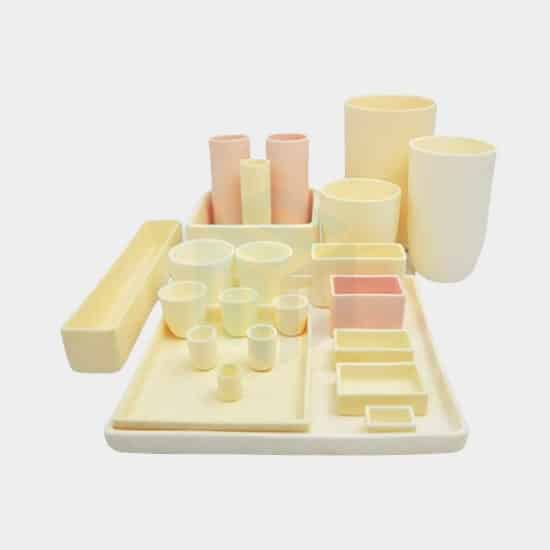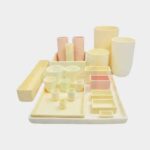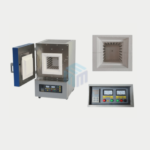When it comes to melting precious metals like gold, silver, and platinum, the choice of crucible can make or break the quality and efficiency of your process. Alumina ceramic (Al₂O₃) crucibles are a common option in high-temperature applications—but are they truly suitable for precious metal melting?
Let’s explore the material properties, performance, and key considerations that determine their suitability.
Properties of Alumina Ceramic Crucibles
Alumina ceramic crucibles are made from high-purity aluminium oxide (Al₂O₃), a technical ceramic known for:
- Stability for high temperature(≥1600-17000C)
- Excellent thermal stability
- Strong resistance to corrosion, oxidation, and most acids
- Good electrical insulation properties
- High mechanical strength even at elevated temperatures
Their non-reactive nature and ability to withstand repeated heating cycles make them an ideal choice for demanding thermal processes.
Common Applications of Alumina Crucibles
Thanks to their robust properties, Al₂O₃ crucibles are widely used across:
- Metal and alloy melting
- Chemical analysis and materials research
- Thermal processing in laboratories
- Glass melting and crystal growth
- High-purity sample preparation
They are especially favoured where chemical purity and thermal endurance are essential.
Suitability for Melting Precious Metals
Alumina crucibles are well-suited for melting precious metals due to their high thermal stability, chemical inertness, and resistance to corrosion. They maintain purity and withstand extreme temperatures without reacting with the molten metal, making them ideal for high-quality metallurgical processes.
Melting Points of Precious Metals
To assess compatibility, it’s important to consider the melting temperatures of common precious metals:
| Metal | Melting Point (°C) |
|---|---|
| Gold | 1,064 |
| Silver | 961 |
| Platinum | 1,768 |
Alumina’s high melting point of over 1713°C comfortably exceeds these, offering ample thermal headroom for melting precious metals.
Compatibility of Alumina with Gold, Silver, and Platinum
Alumina is chemically inert and does not react with gold, silver, or platinum under standard melting conditions. This helps ensure:
- Minimal contamination of the melt
- Preservation of metal purity
- Reliable results for refining and alloying
It is especially preferred in analytical labs and jewellery workshops seeking high-quality results.
Performance Under High-Temperature Conditions
Al₂O₃ crucibles handle repeated heating and cooling cycles well, making them reliable for melting operations involving:
- Propane or oxy-fuel torches
- Resistance or muffle furnaces
- Laboratory kilns
However, care must be taken to avoid thermal shock, especially if heating or cooling is too rapid.
Factors to Consider Before Using Al₂O₃ Crucibles
Before using Al₂O₃ crucibles, consider their maximum temperature tolerance, compatibility with the materials being melted, and potential for thermal shock. Proper handling and preheating are essential to avoid cracking and ensure long-term durability.
Effects of Flux and Additives
Fluxes used in metal refining (e.g., borax, soda ash) can react with alumina at high temperatures and potentially degrade the crucible lining. To avoid this:
- Choose high-density, high-purity crucibles
- Limit the use of aggressive flux additives
- Monitor for any softening or erosion signs
Risk of Thermal Shock and Cracking
Alumina, like most ceramics, is brittle and prone to thermal stress. To reduce cracking risks:
- Heat and cool gradually
- Preheat crucibles to drive off any residual moisture
- Avoid placing cold crucibles in hot furnaces
Crucible Life and Maintenance Tips
With proper care, an alumina crucible can last dozens of cycles. Tips to extend service life:
- Avoid mechanical impact or shock
- Clean gently after each use
- Store in dry, temperature-stable environments
Read also: How to Select the Appropriate Crucibles for Your Applications Based on its Features and Uses
Applications Beyond Precious Metal Melting
Beyond precious metal work, alumina crucibles are valuable in:
- Ceramic sintering and powder metallurgy
- Oxide and non-oxide material research
- Semiconductor processing
- Glass, pigment, and enamel production
Their high-purity, non-contaminating structure makes them a staple in scientific and industrial settings alike.
Conclusion
Yes — Al₂O₃ crucibles are highly suitable for melting precious metals. With a high melting point, chemical inertness, and thermal durability, they offer an excellent balance of performance and purity. While some care is needed to prevent thermal shock and flux corrosion, their overall advantages make them a trusted choice in laboratories, refineries, and jewellery production.






